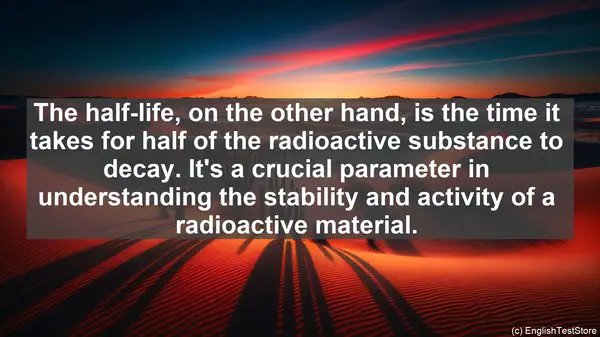Introduction: The Importance of Precision in Nuclear Engineering
Welcome to today’s lesson. In the field of nuclear engineering, precision is of utmost importance. A slight misunderstanding or confusion in terms can lead to significant consequences. That’s why we’re here today, to discuss the top 10 commonly confused words in this domain.
1. Reactor vs. Generator
The first pair of words that often cause confusion is ‘reactor’ and ‘generator.’ While both are integral to a nuclear power plant, they serve different purposes. A reactor is responsible for initiating and controlling the nuclear chain reaction, while a generator converts the energy produced by the reactor into electricity.
2. Fission vs. Fusion
Next, let’s talk about ‘fission’ and ‘fusion.’ These terms refer to two different processes of releasing nuclear energy. Fission involves splitting a heavy nucleus into smaller fragments, while fusion is the process of combining two light nuclei to form a heavier one. Both processes release a tremendous amount of energy, but they differ in their applications and requirements.

3. Isotope vs. Element
Moving on, ‘isotope’ and ‘element’ are often used interchangeably, but they have distinct meanings. An element is defined by the number of protons in its nucleus, while isotopes of an element have the same number of protons but differ in the number of neutrons. This variation in neutron count gives isotopes different atomic masses.
4. Decay vs. Half-life
When discussing radioactive materials, ‘decay’ and ‘half-life’ are frequently mentioned. Decay refers to the spontaneous disintegration of an unstable nucleus, emitting radiation in the process. The half-life, on the other hand, is the time it takes for half of the radioactive substance to decay. It’s a crucial parameter in understanding the stability and activity of a radioactive material.
5. Neutron vs. Neutrino
Let’s now clarify the difference between ‘neutron’ and ‘neutrino.’ Both are subatomic particles, but they have distinct properties. Neutrons are electrically neutral and are found in the nucleus, while neutrinos are elementary particles with negligible mass and no electric charge. They are produced in various nuclear reactions and are notoriously difficult to detect.
6. Shielding vs. Containment
In the context of nuclear safety, ‘shielding’ and ‘containment’ are crucial concepts. Shielding refers to the use of materials to absorb or attenuate radiation, protecting the surroundings. Containment, on the other hand, involves preventing the release of radioactive materials into the environment, often through robust physical barriers.
7. Criticality vs. Subcriticality
The terms ‘criticality’ and ‘subcriticality’ are used to describe the state of a nuclear reactor. When a reactor is critical, it means that the neutron population is stable, and a self-sustaining chain reaction is occurring. Subcriticality, on the other hand, indicates that the reactor is not self-sustaining, and the neutron population is decreasing.
8. Enrichment vs. Depletion
Enrichment and depletion are terms associated with the concentration of isotopes in a material. Enrichment refers to increasing the proportion of a specific isotope, often for fuel production. Depletion, on the other hand, is the reduction in the concentration of a particular isotope, usually due to its use or decay.
9. Transmutation vs. Transformation
In the realm of nuclear reactions, ‘transmutation’ and ‘transformation’ are frequently used. Transmutation refers to the conversion of one element into another, often through nuclear reactions. Transformation, on the other hand, is a broader term that can encompass various changes, not necessarily involving nuclear processes.

10. Moderator vs. Absorber
Lastly, let’s clarify the difference between ‘moderator’ and ‘absorber.’ In a nuclear reactor, a moderator is a material that slows down fast neutrons, increasing the likelihood of their interaction with other nuclei. An absorber, on the other hand, is a material that readily captures neutrons, reducing their population and thus controlling the reaction rate.
